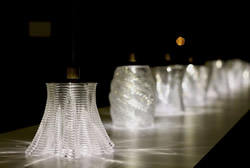Why being able to 3-D print glass objects is such a big deal
 By Dominic Basulto for the Washington Post: Researchers at MIT have just unveiled the ability to 3-D-print beautiful glass objects. While humanity has been forming, blowing and molding glass objects for more than 4,500 years, this is the first time that a 3-D printer has been used to process glass from a molten state to an annealed product.
By Dominic Basulto for the Washington Post: Researchers at MIT have just unveiled the ability to 3-D-print beautiful glass objects. While humanity has been forming, blowing and molding glass objects for more than 4,500 years, this is the first time that a 3-D printer has been used to process glass from a molten state to an annealed product.
Obviously, there are some purely aesthetic applications here, as in the potential for epic blown glass art. Think museum-worthy glass objects worthy of Dale Chihuly. In fact, the MIT team — a collaborative team of researchers that includes the MIT Media Lab’s Mediated Matter group, the MIT Glass Lab and MIT’s Mechanical Engineering Department — plan to display a few of their beautiful objects at an upcoming exhibition at the Cooper Hewitt, Smithsonian Design Museum in 2016.
But the applications go beyond just beautiful new designs that might be created via 3-D printers one day. As the MIT research team points out in a forthcoming paper for the journal 3-D Printing and Additive Manufacturing, “As designers learn to utilize this new freedom in glass manufacturing it is expected that a whole range of novel applications will be discovered.” That’s the real future potential of glass 3-D printing — the ability to create objects and applications that do not exist today. Cont'd...
Comments (0)
This post does not have any comments. Be the first to leave a comment below.
Featured Product

